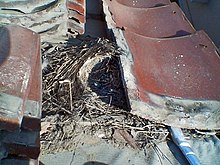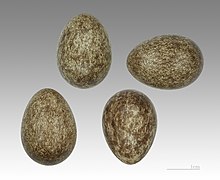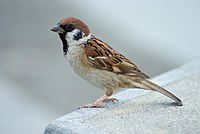Tree Sparrow
| Tree Sparrow | ||||||||||||
|---|---|---|---|---|---|---|---|---|---|---|---|---|

Tree Sparrow ( Passer montanus ) |
||||||||||||
| Systematics | ||||||||||||
|
||||||||||||
| Scientific name | ||||||||||||
| Passer montanus | ||||||||||||
| ( Linnaeus , 1758) |
The tree sparrow or Field Sparrow ( Passer montanus ) is a common Eurasian bird art in the family of sparrows (Passeridae). It is a little smaller than the house sparrow and, in the west of the Palearctic, less adapted to humans and much more shy. In Central Europe, it is usually absent as a breeding bird in the interior of villages and cities, but in some regions of the Mediterranean and Asia it is a pronounced urban bird and occupies the ecological niche that the house sparrow occupies in other regions.
The tree sparrow breeds in trees, orchards, avenues and gardens near agricultural areas or settlements. The nest is in tree hollows, wall niches, rock crevices, nest boxes or between climbing plants on walls and under roofs. The IUCN classifies the tree sparrow as not endangered ( least concern ). In the 2015 Red List of Breeding Birds in Germany, the species is on the pre-warning list.
Appearance
The tree sparrow is up to 14 centimeters tall and weighs 20 to 24 grams. The wing length is between 6.8 and 7.4 centimeters in males and between 6.6 and 7.1 centimeters in females. The male's tail is between 4.8 and 5.8 centimeters, while the females have between 5 and 5.6 centimeters. Overall, there is no noticeable sexual dimorphism .
The tree sparrow is drawn a little more neatly than the house sparrow and is overall somewhat smaller and slimmer than the house sparrow. The top of the head and the nape of the neck are brown, the throat has a small black throat patch. The cheeks are white with a black spot around the ears. The light-colored collar is almost closed at the neck. The top of the body is brownish with darker vertical stripes that are particularly noticeable on the back and shoulders. The rump is yellow-brown, the belly and breast are brown-gray. The wings have two white bands.
Young birds are similar to adult birds, but are more gray-brown on the top of the head. The upper side of the body is paler with gray longitudinal stripes, the cheek and throat patches are still soot gray. They go through full moults about five to eight weeks after flinging and show their first adult plumage after an average of 77 days. The nestlings are initially naked. They have pink skin, the throat and tongue are pink too. The beak ridges are pale yellow in them.
Vocalizations
The call of the tree sparrow is similar to that of the house sparrow, but the calls are quieter and often softer than the house sparrow. Typical sound utterances include a wooden tek tek tek and bright zwit sounds, which are easily distinguishable from those of the house sparrow. The song is a rhythmic chirping, the onomatopoeic with Chechnya is circumscribed.
Distribution area
The tree sparrow occurs in Europe and Asia from the Atlantic to the Pacific. In Europe it is absent in Iceland, in parts of Scotland and Ireland, and in large parts of Scandinavia and Finland; Large parts of Greece and parts of Asia Minor are also not settled. In Asia, however, it is very widespread and is only absent in the southwest and in large parts of the Indian subcontinent. Its extreme southern range includes northern Africa, Iran, Afghanistan, the Malay Peninsula and western Indonesia. It is predominantly a resident bird, but there is a southward migratory movement in some populations in the winter months. The population density therefore increases in the winter half of the year in northern Africa, southern Europe, Turkey and the north of the Indian subcontinent. A small number cross the Strait of Gibraltar from September to mid-November to winter in North Africa. The return flight takes place between March and April.
In Central Europe the tree sparrow is a widespread and frequent breeding bird in the lowlands. In Africa it is relatively rare as a breeding bird: breeding occurrences are limited to a few pairs in Morocco; in Tunisia five to ten breeding pairs have been counted annually since 1974. In Algeria and Egypt, tree sparrows are only random visitors .
The tree sparrow has been introduced in several countries. Today it is one of the breeding bird populations in North America, the Canary Islands, western Micronesia, the Philippines and Australia.
Habitat and general way of life
The habitat is sparsely forested regions, forest edges, field edges, hedges, avenues, gardens and the edge of settlements. In western Europe in particular, the tree sparrow is a less pronounced cultural follower than the house sparrow. In Germany, however, it is increasingly penetrating cities and villages and occupying the niche of the house sparrow, which is becoming rarer.
The tree sparrow is a sociable bird that forms groups outside of the breeding season, which can consist of a few to several thousand individuals. These troops nomadize in areas that are up to 100 square kilometers in size. During this time the tree sparrow is often associated with house and willow sparrows as well as finches and bunting. Extended dust baths are part of the typical comfort behavior of tree sparrows. The place where they take their dust bath is often aggressively defended against conspecifics.
food
The diet consists mainly of seeds of grasses , herbs and grains . Most of the food is taken from the soil. However, grass and grain seeds are also picked from the ears while the tree sparrows sit on the stalks. Alternatively, they bend the ears to the ground and then pick out the seeds. They also occasionally eat buds and berries and look for food in human waste. The young are fed with insects .
Brood care
Pair bond
Tree sparrows are predominantly monogamous birds; once they have entered into a pair relationship, they last until one of the two partner birds dies. A few males, on the other hand, are polygamous, they usually mate with the females near their nest whose partner bird has died. Tree sparrows breed very often in loose colonies, the size of the colony depends largely on the available nest locations. The immediate nest environment is defended. Tree sparrows are predominantly cave and niche breeders, but they also occasionally build free nests. Courtship begins with the males occupying a breeding site. The unmated male advertises with fluffed plumage in the narrower nest area. If a female expresses interest, the male shows him the nesting place by slipping dry stalks in the beak. The female follows the male by briefly hatching and checking the nesting site.
The nest is a spherical structure or a messy bowl made of stalks, stems, roots and leaves. The nesting trough is lined with feathers and hair. Both parent birds are equally involved in building the nest. The nest is usually built within five days, with the partner birds returning to the nesting site with building material every two to six minutes.
Breeding course
The breeding season begins in Central Europe from mid-April to early May. Tree sparrows usually raise broods for two or three years.
The cluster of tree sparrows consists of four to six eggs, in rare exceptions the clutch can also contain nine eggs. The eggs are spindle-shaped with a smooth shell that is faintly shiny. The eggs are smaller than in the house sparrow and less variable in color than in this species. On a white or pale gray background they have dark brown, occasionally purple or grayish spots and small blobs. The staining is sometimes so dense that the base color of the peel can no longer be made out. The blunt pole of the egg is usually drawn darkest.
Both parent birds breed, but the female's share of the breeding business is higher. The brood is usually picked up after the last egg has been laid, the incubation period is between 11 and 14 days. The nestlings are nestlings that are cared for by both parent birds. The female parent bird herds the young during the first eight days of life.
The eyes of the initially blind nestlings open on the fifth day of life, on the 10th day of life they come to the nest entrance to receive food. During the first four to five days they are fed exclusively with insects by the parent birds, after which they are increasingly given vegetable food. With an age of 15 to 20 days the young birds are fully fledged. If the broods overlap, the male takes care of the first brood, while the female sits on the second clutch and breeds. Tree sparrows first breed when they are one year old.
Predators and causes of mortality
The sparrow's hawk and tawny owl are among the most important flying predators of the field sparrow , while the buzzard , peregrine falcon and kestrel play a subordinate role . Among the mammals, the house cat is the strongest predator , but weasels, martens, squirrels and even mice also eat nestlings or eggs.
There are several studies on the reproductive success of tree sparrows, but they have come to very different results: According to them, a pair of tree sparrows raise between 1.2 and 8 young birds per year.
The sparrow as a pest
The earlier reputation of the sparrow as a pest is mainly due to its predilection for grains. The sparrow was also far more numerous than today until the beginning of the 20th century. In the middle of the 20th century, for example, on the orders of Mao Zedong, as part of the so-called “Great Sparrow Campaign” in Beijing alone, almost half a million field sparrows were caught and killed within three days. The subsequent flood of insects had to be combated by importing many sparrows from Russia.
Subspecies
10 subspecies are recognized:
- Passer montanus montanus ( Linnaeus , 1758)
- Passer montanus transcaucasicus Buturlin , 1906
- Passer montanus dilutus Richmond , 1896
- Passer montanus kansuensis Stresemann , 1932
- Passer montanus tibetanus Baker, ECS , 1925
- Passer montanus dybowskii Domaniewski , 1915
- Passer montanus iubilaeus Reichenow , 1907
- Passer montanus obscuratus Jacobi , 1923
- Passer montanus malaccensis Dubois, AJC , 1885
- Passer montanus saturatus Stejneger , 1885
- Passer montanus hepaticus Ripley 1948
The subspecies Passer montanus iubilaeus , which Reichenow described in 1907, corresponds to P. m. saturatus . One can also find the Ssp. Passer montanus zaissanensis , described by Polyakov in 1911. This subspecies is the Ssp described earlier. P. m. dilutus .
literature
- Gisela Deckert : The tree sparrow: Passer montanus , Westarp Wissenschaftliche VG, Hohenwarsleben 2004, ISBN 3-89432-782-0 (reprint of the Wittenberg 1973 edition).
- C. Hilary Fry and Stuart Keith (Eds.): The Birds of Africa. Volume VII. Christopher Helm, London 2004, ISBN 0-7136-6531-9 .
- Collin Harrison and Peter Castell: Fledglings, Eggs and Nests of Birds in Europe, North Africa and the Middle East. Aula Verlag, Wiebelsheim 2004, ISBN 3-89104-685-5 .
- J. Denis Summers-Smith: The Tree Sparrow , Summers-Smith, Guisborough 2004, ISBN 0-9525383-0-X .
Web links
- Photos and information about the tree sparrow (at www.naturfotografie-digital.de)
- Passer montanus inthe IUCN Red List of Threatened Species 2010.4. Listed by: BirdLife International, 2009. Retrieved December 22, 2010.
- Videos, photos and sound recordings on Passer montanus in the Internet Bird Collection
- Age and gender characteristics (PDF; 1.7 MB) by Javier Blasco-Zumeta and Gerd-Michael Heinze (English)
- Feathers of the tree sparrow
Single receipts
- ↑ Christoph Grüneberg, Hans-Günther Bauer, Heiko Haupt, Ommo Hüppop, Torsten Ryslavy, Peter Südbeck: Red List of Germany's Breeding Birds , 5 version . In: German Council for Bird Protection (Hrsg.): Reports on bird protection . tape 52 , November 30, 2015.
- ^ Harrison, p. 426
- ↑ Fry et al., P. 33
- ↑ Fry et al., Pp. 32-33
- ↑ Fry et al., P. 32
- ↑ Fry et al., P. 33
- ↑ Fry et al., P. 34
- ↑ Fry et al., P. 34
- ^ Harrison, p. 426
- ↑ Fry et al., P. 34
- ↑ Fry et al., P. 34
- ↑ 58 years ago - huge sparrow extermination in China









